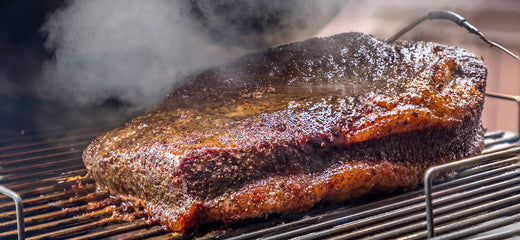How to Smoke a Brisket
Jan 15, 2025
That is a good question. Smoking a brisket is the ultimate when it comes to BBQ! However, it can be intimidating. The good news is if cooked correctly, your brisket will be tender, juicy, and full of flavor! In this article we will be discussing how to inject a brisket and smoke a brisket low and slow.
Before you Begin
Before you begin you will want to decide if you want to use a brisket injection. We would recommend some type of beef brisket injection to introduce flavor and moisture into the brisket flat.
Smoking a brisket can dry out the flat because it lacks intramuscular fat or “marbling”. The brisket point contains a lot of marbling, so it is not necessary to inject the point.
Trimming the Brisket
You will find many different opinions about whether to trim or not to trim a brisket before you smoke a brisket. We would suggest trimming the fat cap to an even quarter of an inch across the brisket.
You can shape it to make the brisket more “aerodynamic” for the smoke to flow across. Or you can simply not trim anything off your brisket and just smoke it!
Injecting the Brisket
A lot of pitmasters only use a brisket injection for the flat, but you can also inject the point as well. So now that you have decided to inject your brisket, we would like to recommend a good brisket injection, Butcher BBQ Prime Brisket Injection. It is an amazing brisket injection for adding beefy flavor and moisture to your brisket.
Next, follow the instructions on your injection to properly mix the brisket injection. Grab your beef brisket injector and shoot the mixture into the meat. We would suggest injecting the whole flat of the brisket in a checkerboard pattern.
Adding Brisket Rub
Now that you have injected your brisket, it is time to add some rub. You can simply use salt and pepper for an authentic Texas brisket, or you can add your favorite rub. We would suggest a salt pepper garlic rub or SPG BBQ rub to maximize your bark development.
Hold the rub container 3-6 inches above the brisket and gently shake to evenly distribute the SPG BBQ rub. We would suggest lightly pressing the rub against the surface of the brisket. After adding the rub, set it in the refrigerator letting the rub and brisket injection penetrate the brisket for at least 30 minutes.
Prepare the Smoker
Ahh the different types of smokers! Whether you have a barrel type of smoker, ceramic smoker, or pellet smoker, the grate temperature will need to be between 225-250 degrees. Again, we are smoking a brisket low and slow.
Time to start cooking
Once your smoker stabilizes the temperature, it is time to start smoking the brisket! Your brisket injection and SPG BBQ rub have had time to penetrate the meat fibers. Place the brisket, fat side up, on the pit and let the cooking begin. We would also suggest adding a temperature probe in the middle of the flat. This way you can easily monitor the internal temp and know when it is time to wrap.
The Stall
The dreaded stall! The stall happens when the brisket internal temp reaches around the 160 degree mark. This is a phenomenon that occurs when the internal temp stops rising. Not to worry, this is normal! Keep your grate temp around 225-250, it will take several hours, but eventually you will push through the stall. Trust us, it is worth the wait!
Time to Wrap
There are a lot of debates on when to wrap, but a good internal temperature range would be 165-170. This depends on how much bark you want to form. You can wrap a brisket in aluminum foil or butcher paper.
Here are a couple things to keep in mind. Butcher paper is generally preferred for maintaining a firmer bark. Aluminum foil traps moisture and could result in a softer bark. After wrapping, put the brisket back on the pit.
Time to Rest
After your brisket reaches an internal temperature of 200-210, it is time to rest. Your brisket should be probing tender using a thermometer or a toothpick. For the best results you will want to rest your brisket for at least 30 minutes, but several hours is best. Some recommend waiting until the internal temperature has cooled to 140 degrees before serving.
Do not skip this step! Resting allows the brisket to absorb some of the juices back into the meat.
In Summary
Smoking a brisket takes time to prep and cook. While some of us struggle with patience, this truly pays off in the end. After smoking a brisket for 12-18 hours it produces an amazing, smokey, and delicious brisket your family will love!
What are you waiting for? Fire up that pit and smoke a brisket!



